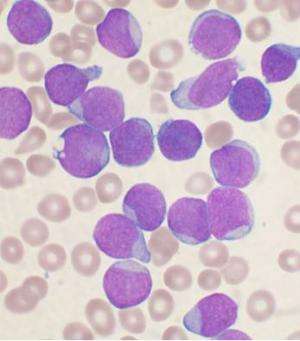Researchers discover new way to monitor leukaemia

Researchers at The University of Western Australia have invented a new, highly sensitive way of monitoring leukaemia cells in the blood. The research, published in the journal Methods, describes the new technique that can detect genetic changes inside the leukaemia cell.
This adds a new dimension to way leukaemia can be assessed and treatment decisions made.
The method they have developed, named Immuno-flowFISH, enables the chromosomes and the whole leukaemia cell to be seen using a microscope built into the instrument used for this test. More than 20,000 cells can be studied in one test, a vast improvement on current methods which only assess a few hundred cells and are much slower.
The UWA team is the first in the world to have been able to do this. The name has been derived to acknowledge that three tests have been incorporated into one: 'immuno' recognises that immunology testing is used to identify the leukaemia cells.
'Flow' because the machine is an 'imaging flow cytometer', and 'FISH' is the name of the test that identified the chromosomes inside the cells.
The team has developed and applied the immuno-flowFISH method to study chronic lymphocytic leukaemia, the most common type of leukaemia in Australia and which affects three per cent of people over 60 years of age.
Detecting the chromosomes in these leukaemia cells is important in determining the treatment and likely outcome for the patient.
Dr. Kathy Fuller, a researcher at the Translational Cancer Pathology Laboratory said the method could allow the detection of cancer cells when there are only very few of them. "This will allow it to be used as a sensitive test to monitor the cancer," Dr. Fuller said.
"The imaging cytometer can analyse samples at a rate of up to 2,000 cells per second which means we can investigate a large number of cells in a relatively short amount of time, giving us greater sensitivity."
Co-author Professor Wendy Erber said the breakthrough will significantly improve the ability to identify genetic changes in cancer cells that will impact treatment.
"This immuno-flowFISH method is an exciting development in personalising pathology testing for leukaemia," she said. Professor Erber and her research team are now expanding the test so that it can be applied to other types of leukaemia and cancers.
The team is hoping to develop this research to include all types of blood and bone marrow cancers and are calling for volunteers to speak to their haematologist, who are aware of this research, about joining the study.
More information: Henry Hui et al. Imaging flow cytometry to assess chromosomal abnormalities in chronic lymphocytic leukaemia, Methods (2017). DOI: 10.1016/j.ymeth.2017.11.003

















